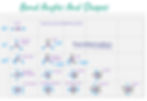Table of Contents
Shapes of Molecules and Their Bond Angles

We need to use this chart and memorize it to determine the molecular geometry/shape of a molecule.
First, we must start with the correct Lewis Dot Structure. Next, we have to find the central atom and identify how many other atoms it is attached to (please do not count bonds) and how many lone pairs of electrons (two dots) it has. In the chart, the purple circle represents the central atom, blue circles are atoms the central atom is attached to and two dots represent a lone electron pair.

Let's take a look at the Lewis structure of H2SO4 shown above. The central atom, sulfur, is attached to four other atoms (oxygens) and has no lone pairs of electrons on it. The shape must be tetrahedral with a 109.5 angle.

In the example above, XeF4, Xenon is attached to four other atoms and has two lone pairs of electrons. The shape must be square planar.
Molecular Polarity
A polar molecule is a molecule that has an assymetrical distribution of charge resulting in an overall dipole moment. In order to determine whether the molecule is polar or not, we must first draw out the correct Lewis Dot structure.
Mayya's Trick
A Molecule is NONPOLAR if
It consists of two of the same atoms. Example: H2, O2, N2
OR
The central atom is attached to the same atoms AND the shape of the molecule is one of the following: linear, trigonal planar, tetrahedral, trigonal bipyramidal, octahedral, square planar. Examples:
CCl4(carbon is attached to all the same atoms, chlorines, and the shape of the molecule is tetrahedral)
CO2(carbon is attached to all the same atoms, oxygens, and the shape of the molecule is linear).
If the molecule is not nonpolar, it will be polar and have an overall dipole moment.
NH3 (polar because the shape is bent)
HCl (polar because it consists of two different atoms)
CCl2H2 ( polar because the central atom is not attached to the same atoms)
Contact us to get in touch with an expert Online Chemistry Tutor and ace your General Chemistry Class.
